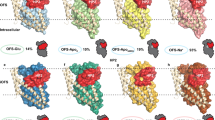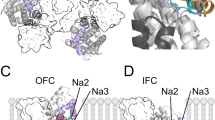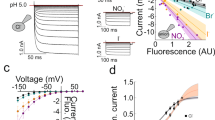Abstract.
Transfer of glutamine between astrocytes and neurons is an essential part of the glutamate–glutamine cycle in the brain. Here we have investigated how the neural glutamine transporter (rATA1/GlnT) works. Rat ATA1 was expressed in Xenopus laevis oocytes and examined using two-electrode voltage-clamp recordings, ion-sensitive microelectrodes and tracer flux experiments. Glutamine transport via rATA1 was electrogenic and caused inward currents that did not reverse at positive holding potentials. Currents were induced by a variety of neutral amino acids in the following relative order Ala>Ser/Gln/Asn/His/Cys/Met >MeAIB/Gly>Thr/Pro/Tyr/Val, where MeAIB is the amino acid analogue N-methylaminoisobutyric acid. The uptake of glutamine and the corresponding currents depended on Na+ and pH. Hill-coefficient and flux studies with 22NaCl indicated a cotransport stoichiometry 1 Na+ per transport cycle. The transporter also showed uncoupled Na+ transport, particularly when alanine was used as the substrate. Although substrate uptake increased strongly with increasing pH, no change of intracellular pH was observed during transport. A decrease of the intracellular pH similarly inhibited glutamine transport via ATA1, suggesting that the pH dependence was an allosteric effect on the transporter.
Similar content being viewed by others
Author information
Authors and Affiliations
Additional information
Electronic Publication
Rights and permissions
About this article
Cite this article
Albers, A., Bröer, A., Wagner, C.A. et al. Na+ transport by the neural glutamine transporter ATA1. Pflügers Arch - Eur J Physiol 443, 92–101 (2001). https://doi.org/10.1007/s004240100663
Received:
Revised:
Accepted:
Published:
Issue Date:
DOI: https://doi.org/10.1007/s004240100663




